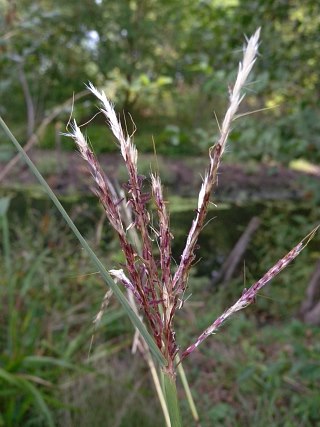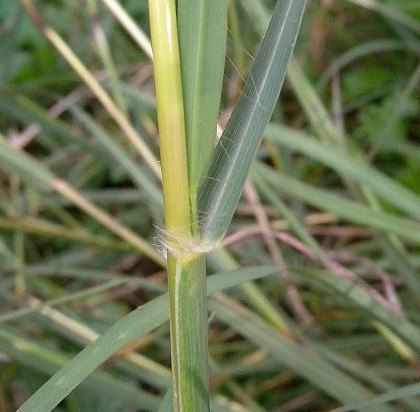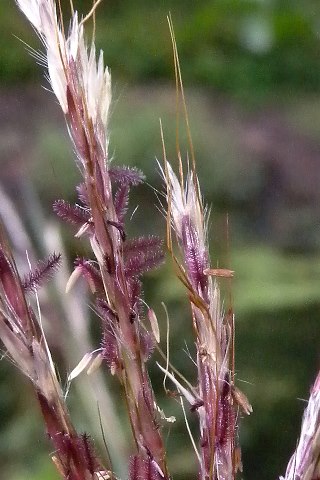 Description:
This perennial grass
consists of a tuft of leafy culms up
to 3' tall. The culms are light green to pale yellow, terete, and
glabrous; they are often decumbent at their bases and either unbranched
or branched (especially below). The interior of each culm consists of a
white pith. Alternate leaves occur along the entire length of each
culm, although they are more abundant below (see photo of Culms
& Leaves).
The leaf blades are
ascending to widely spreading and rather floppy; they are up to 12"
long and 7 mm. across, becoming gradually smaller in size as they
ascend the culm. The upper blade surface is dull medium green or
grayish blue, while the lower surface is dull pale green. The leaf
blades are
mostly hairless, except toward their bases, where scattered white hairs
may occur along their upper surfaces and margins. The ligules are
short-membranous, although rings of white hair may be located nearby.
The nodes
of this grass are brownish purple and either glabrous (var. ischaemum)
or covered with short appressed hairs (var. songarica).
Each culm
terminates in a cluster of 3-12 ascending racemes; this inflorescence
is typically about 3" tall and 2" across, forming a V-shape (see photo
of Inflorescence).
The lateral racemes diverge from the central axis of the inflorescence
along the lowest ½" of its length.
Individual racemes are typically 1-3" long and spike-like; their
rachises
(central stalks) are straight and covered with ascending white hairs.
Along each
rachis, there are pairs of spikelets. The first spikelet of a pair is
perfect and sessile, while the second spikelet of a pair is either
sterile or staminate and it is on a short pedicel (about 1.5 mm. in
length) that is covered with ascending white hairs. Both spikelets are
light
green to purple while immature, becoming nearly white with
age. The sessile spikelet is 3.5-4.0 mm. long (excluding the awn),
ellipsoid in shape, and slightly flattened; there is a tuft of white
hairs at its base. The lower glume of this spikelet is covered with
appressed white hairs along the lower half of its length
and margins, otherwise it is either glabrous or minutely pubescent. The
lemma of this spikelet has an awn about 8-13 mm. long that
is straight or curved. The spikelet with a pedicel is similar to
the sessile spikelet, except its lower glume is glabrous to minutely
pubescent and its lemma is awnless. A perfect floret has a pair of
feathery
stigmata that are dark red or purple, and 3 anthers
that are white to pale yellow, becoming brown with age. When it is
present, a staminate
floret has 3 anthers that are similar to those of the perfect floret.
Description:
This perennial grass
consists of a tuft of leafy culms up
to 3' tall. The culms are light green to pale yellow, terete, and
glabrous; they are often decumbent at their bases and either unbranched
or branched (especially below). The interior of each culm consists of a
white pith. Alternate leaves occur along the entire length of each
culm, although they are more abundant below (see photo of Culms
& Leaves).
The leaf blades are
ascending to widely spreading and rather floppy; they are up to 12"
long and 7 mm. across, becoming gradually smaller in size as they
ascend the culm. The upper blade surface is dull medium green or
grayish blue, while the lower surface is dull pale green. The leaf
blades are
mostly hairless, except toward their bases, where scattered white hairs
may occur along their upper surfaces and margins. The ligules are
short-membranous, although rings of white hair may be located nearby.
The nodes
of this grass are brownish purple and either glabrous (var. ischaemum)
or covered with short appressed hairs (var. songarica).
Each culm
terminates in a cluster of 3-12 ascending racemes; this inflorescence
is typically about 3" tall and 2" across, forming a V-shape (see photo
of Inflorescence).
The lateral racemes diverge from the central axis of the inflorescence
along the lowest ½" of its length.
Individual racemes are typically 1-3" long and spike-like; their
rachises
(central stalks) are straight and covered with ascending white hairs.
Along each
rachis, there are pairs of spikelets. The first spikelet of a pair is
perfect and sessile, while the second spikelet of a pair is either
sterile or staminate and it is on a short pedicel (about 1.5 mm. in
length) that is covered with ascending white hairs. Both spikelets are
light
green to purple while immature, becoming nearly white with
age. The sessile spikelet is 3.5-4.0 mm. long (excluding the awn),
ellipsoid in shape, and slightly flattened; there is a tuft of white
hairs at its base. The lower glume of this spikelet is covered with
appressed white hairs along the lower half of its length
and margins, otherwise it is either glabrous or minutely pubescent. The
lemma of this spikelet has an awn about 8-13 mm. long that
is straight or curved. The spikelet with a pedicel is similar to
the sessile spikelet, except its lower glume is glabrous to minutely
pubescent and its lemma is awnless. A perfect floret has a pair of
feathery
stigmata that are dark red or purple, and 3 anthers
that are white to pale yellow, becoming brown with age. When it is
present, a staminate
floret has 3 anthers that are similar to those of the perfect floret.
The blooming period occurs from late summer into the fall, lasting about 2 weeks. The florets are cross-pollinated by the wind. Fertile perfect florets are replaced by grains (about 3.0 mm. in length) that are narrowly ellipsoid and somewhat flattened in shape; the grain exteriors are usually covered with short fine hairs. Because the grains are very light, they can be blown about by the wind in open areas. The root system consists of a tuft of fibrous roots.
Cultivation: The preference is full sun, mesic to dry conditions, and relatively barren soil containing some sand, gravel, or clay. Waterlogged conditions are not tolerated. This warm-season grass has a C4 metabolism, enabling it to withstand hot dry weather. It has some tolerance to salt. There are different cultivars of this grass. The culms have a tendency to sprawl on rich soil.
Range & Habitat: So far, the introduced Old World Bluestem has been found only in Champaign County, Illinois (see Distribution Map), which is north of its primary range in North America. This grass is native to parts of Europe, central and east Asia, the Middle-East, and Africa. In North
 America, this
grass has been found primarily in Texas
and other southern states. It was introduced as a possible source of
forage for cattle, although it is now regarded as invasive and weedy in
some areas of North America. Habitats include pastures, grassy areas
along roads, relatively open areas along streams, and
other disturbed areas. This grass tolerates grazing and fire.
America, this
grass has been found primarily in Texas
and other southern states. It was introduced as a possible source of
forage for cattle, although it is now regarded as invasive and weedy in
some areas of North America. Habitats include pastures, grassy areas
along roads, relatively open areas along streams, and
other disturbed areas. This grass tolerates grazing and fire.Faunal Associations: Little is known about floral-faunal relationships for this grass in North America. Pooling results across two studies (George et al., 2008; Thompson et al., 2009), it was found that monocultures of this grass had mixed results on populations of grassland birds. Grasshopper Sparrows were more abundant in monocultures of this grass than native prairie, while Savannah Sparrows, Cassin's Sparrows, and Horned Larks were less abundant in monocultures of this grass than native prairie. Populations of Eastern Meadowlarks, Western Meadowlarks, and Dickcissels were about equally abundant in both of these habitats. While the foliage of Old World Bluestem is grazed by cattle, sheep, and other hoofed mammalian herbivores, it is usually considered less productive and desirable for forage than other grasses that are widely available.
Photographic Location: An area near a stream at Meadowbrook Park in Urbana, Illinois.
Comments: Grasses in the Bothriochloa genus (Beard Grasses) are closely related to grasses in the Andropogon genus (Bluestem Grasses) and Erianthus genus (Plume Grasses). At one time, Old World Bluestem was classified as Andropogon ischaemum. This grass has other common names that vary with its cultivar and geographic location, among them: King Ranch Bluestem, Texas Yellow Beardgrass, Turkistan Bluestem, Yellow Bluestem, and Plains Bluestem. The common name, King Ranch Bluestem, refers to a large ranch in southern Texas where this grass became very abundant, and where it is still abundant. Distinguishing Old World Bluestem from similar species is rather difficult. Some key characteristics to consider include: 1) the spikelets occur in pairs, and the lower spikelet of each pair is more hairy than the upper spikelet, 2) the spikelets are typically 3.5-4.0 mm. in length, and 3) the lateral racemes diverge from the central axis of the inflorescence along the lowest ½" of its length, creating a finger-like appearance.